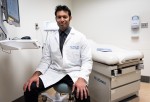UCLA physicians confirmed the efficacy of an unconventional therapy for prostate cancer that significantly reduces the number of required radiotherapy treatments.
In a study published in early February, researchers revealed shorter radiotherapy treatment was just as effective as traditional long-course therapy and created no additional side effects. Researchers pooled data from a large number of individual patients from different institutions who underwent the modified treatment plan.
Amar Kishan, assistant professor of radiation oncology and lead author of the study, said prostate cancer radiotherapy plans typically involve a small daily dose of radiation delivered over eight to nine weeks. The new therapy, which was first pioneered over a decade ago, delivers four to five higher doses of radiation over 10 days.
The shorter-course treatment is highly effective, with more than 95 percent of patients in the study becoming disease-free seven years after treatment, Kishan said. He added there was initial concern the higher doses may lead to more severe side effects, but the study revealed the side effects were indistinguishable from those of the conventional long-course treatment.
“If it’s equally effective and safe, (the shorter-course treatment) should become the standard,” Kishan said. “We’re talking 40 treatments versus four or five – it’s a big difference in the burden on patients.”
Michael Steinberg, professor and chair of radiation oncology and an author on the paper, said the shorter-course treatment was not only more convenient for patients, but also less expensive.
“We actually did something very unusual in medicine, which is to decrease the cost of care,” Steinberg said. “Usually, the cost goes up the more the technology develops.”
He said the new treatment was initially met with resistance from insurance companies that didn’t realize the costs would be lower and refused to cover the costs, as well as from private practices that stood to make less money from the shortened treatment plan.
“Back when the trial was first started in 2009, this (new treatment) was considered not just cutting-edge but way out there,” Steinberg said.
Steinberg added despite the initial pushback, patients greatly preferred the new therapy to conventional treatment, which drove the popularization of the treatment. He said the National Comprehensive Cancer Network, a cancer center consortium that dictates treatment options for cancer, now includes the shortened treatment in their guidelines, and more physicians nationwide are being trained on the new technique.
Christopher King, associate professor of radiation oncology and urology and lead senior author of the paper, said despite the new treatment’s popularization, it still faces some resistance from insurers.
“Ironically, the new treatment is less expensive but many insurers still decline it,” King said. “When insurance companies make policy decisions and they have someone checking their checklist not looking at the downstream consequences, they end up declining (to cover treatments) left and right even though not realizing they’ll be paying two times more.”
He added while more physicians are becoming familiarized with the technique, many institutions and centers still do not have the proper technology and training to perform it. However, like Steinberg, he said he thinks patient demand is driving the increasing popularization of the treatment and publications like these that give credence to the treatment’s long-term efficacy and safety.
“Publishing on (the new treatment) gives confidence that there’s long-term follow-up, and patients are becoming aware of this through publications, support groups and talking to their friends,” King said. “This is no longer that new, but for many practitioners, it’s still considered something they’re not comfortable or familiar with … but the word is getting out.”

Thank you for the news. Your article however should include information about the origin of this new treatment. Where was it first devised tried out ?